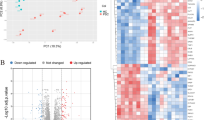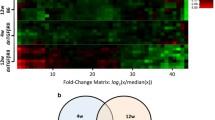Abstract
Objective
To explore the mechanisms of fulminant hepatitis (FH) in the early stages, and to determine the critical pathways in its initiation and progression.
Methods
Twelve BALB/c mice were divided into four groups: one group left as negative control and sacrificed immediately after injection of phosphate-buffered saline (PBS), and another three groups with concanavalin A (Con A) administration sacrificed at 1, 3, and 6 h after injection. Affymetrix GeneChip® Mouse 430 2.0 Array was employed to evaluate the expression profile of each of the 12 samples. Further analysis was done on the microarray data to extract the genes that were differentially expressed. Enrichment analysis was carried out to determine relevant pathways within which regulated genes were significantly enriched.
Results
A total of 393, 8354 and 11344 differentially expressed genes were found, respectively, at three time points. During 0–1 h and 1–3 h, most of the pathways enriched with regulated genes were related to immune response and inflammation, among which Toll-like receptor (TLR) signaling and mitogen-activated protein kinase (MAPK) signaling appeared during both phases, while cytokine-cytokine receptor interaction, apoptosis, T cell receptor signaling, and natural killer (NK) cell-mediated cytotoxicity pathways emerged during the second phase. Pathways found to be significant during 3–6 h were mostly related to metabolic processes.
Conclusion
The TLR signaling pathway dominates the early responses of Con A-induced FH in mice. It stimulates the production of type I cytokines, therefore recruiting and activating T/NK cells. Activated T/NK cells exert their cytotoxicity on hepatocytes through inducing death receptor-intermediated apoptosis, resulting in liver injury.
Similar content being viewed by others
References
Ashburner, M., Ball, C.A., Blake, J.A., Botstein, D., Butler, H., Cherry, J.M., Davis, A.P., Dolinski, K., Dwight, S.S., Eppig, J.T., et al., 2000. Gene ontology: tool for the unification of biology. Nat. Gene., 25(1):25–29. [doi:10.1038/75556]
Crispe, I.N., 2009. The liver as a lymphoid organ. Annu. Rev. Immunol., 27(1):147–163. [doi:10.1146/annurev.immunol.021908.132629]
Deyholos, M.K., Galbraith, D.W., 2001. High-density microarrays for gene expression analysis. Cytometry, 43(4):229–238. [doi:10.1002/1097-0320(20010401)43:4<229::AID-CYTO1055>3.3.CO;2-U]
Ding, W.X., Yin, X.M., 2004. Dissection of the multiple mechanisms of TNF-α-induced apoptosis in liver injury. J. Cell. Mol. Med., 8(4):445–454. [doi:10.1111/j.1582-4934.2004.tb00469.x]
Eisen, M.B., Spellman, P.T., Brown, P.O., Botstein, D., 1998. Cluster analysis and display of genome-wide expression patterns. Proc. Natl. Acad. Sci. USA, 95(25):14863–14868. [doi:10.1073/pnas.95.25.14863]
Gao, L.F., Liu, J.Y., Tang, H.M., Xiao, W.J., 2002. Effect of Con A on macrophage activity. Chin. J. Cell Mol. Immunol., 18(2):104–106 (in Chinese).
Hatano, E., 2007. Tumor necrosis factor signaling in hepatocyte apoptosis. J. Gastroenterol. Hepatol., 22(S1):S43–S44. [doi:10.1111/j.1440-1746.2006.04645.x]
Huang, D.W., Sherman, B.T., Lempicki, R.A., 2009. Systematic and integrative analysis of large gene lists using DAVID Bioinformatics Resources. Nature Protoc., 4(1):44–57. [doi:10.1038/nprot.2008.211]
Ichai, P., Samuel, D., 2008. Etiology and prognosis of fulminant hepatitis in adults. Liver Transpl., 14(S2):S67–S79.
Irizarry, R.A., Bol, B.M., Collin, F., Cope, L.M., Hobbs, B., Speed, T.P., 2003. Summaries of Affymetrix GeneChip probe level data. Nucleic Acids Res., 31(4):e15. [doi:10.1093/nar/gng015]
Kanehisa, M., Goto, S., Furumichi, M., Tanabe, M., Hirakawa, M., 2010. KEGG for representation and analysis of molecular networks involving diseases and drugs. Nucleic Acids Res., 38(database):D355–D360. [doi:10.1093/nar/gkp896]
Kaneko, Y., Harada, M., Kawano, T., Yamashita, M., Shibata, Y., Gejyo, F., Nakayama, T., Taniguchi, M., 2000. Augmentation of Valpha14 NKT cell-mediated cytotoxicity by interleukin 4 in an autocrine mechanism resulting in the development of concanavalin A-induced hepatitis. J. Exp. Med., 191(1):105–114. [doi:10.1084/jem.191.1.105]
Lauzon, N.M., Mian, F., MacKenzie, R., Ashkar, A.A., 2006. The direct effects of Toll-like receptor ligands on human NK cell cytokine production and cytotoxicity. Cell. Immunol., 241(2):102–112. [doi:10.1016/j.cellimm.2006.08.004]
Leifeld, L., Dumoulin, F.L., Purr, I., Janberg, K., Trautwein, C., Wolff, M., Manns, M.P., Sauerbruch, T., Spenfler, U., 2003. Early up-regulation of chemokine expression in fulminant hepatic failure. J. Pathol., 199(3):335–344. [doi:10.1002/path.1298]
Liang, T.J., 2009. Hepatitis B: the virus and disease. Hepatology, 49(S5):S13–S21.
Miyazawa, Y., Tsutsui, H., Mizhhara, H., Fujiware, H., Kaneda, K., 1998. In development of intrasinusoidal hemostasis in the development of concanavalin A-induced hepatic injury in mice. Hepatology, 27(2):497–506. [doi:10.1002/hep.510270225]
Ning, Q., Yang, D.L., Luo, X.P., Hao, L.J., Levy, G., 2002. Fulminant viral hepatitis: mice model and its clinical implications. Chin. J. Hepatol., 10(3):224–226 (in Chinese).
Preiss, S., Thompson, A., Chen, C., Rodgers, S., Markovska, V., Desmond, P., Visvanathan, K., Li, K., Locarnini, S., Revill, P., 2008. Characterization of the innate immune signaling pathways in hepatocyte cell lines. J. Viral Hepat., 15(12):888–900. [doi:10.1111/j.1365-2893.2008.01001.x]
Seki, E., Brenner, D.A., 2008. Toll-like receptors and adaptor molecules in liver disease: update. Hepatology, 48(1):322–325. [doi:10.1002/hep.22306]
Song, E., Lee, S.K., Wang, J., Ince, N., Ouyang, N., Min, J., Chen, J., Shankar, P., Lieberman, J., 2003. RNA interference targeting Fas protects mice from fulminant hepatitis. Nat. Med., 9(3):347–351. [doi:10.1038/nm828]
Sorrell, M.F., Belongia, E.A., Costa, J., Gareen, I.F., Grem, J.L., Inodomi, J.M., Kern, E.R., Mchugh, J.A., Petersen, G.M., Rein, M.F., et al., 2009. National Institutes of Health consensus development conference statement: management of hepatitis B. Ann. Intern. Med., 150(2):104–110.
Tan, X.F., Chen, F., Wu, S.S., Shi, Y., Liu, D.C., Chen, Z., 2010. Proteomic analysis of differentially expressed proteins in mice with concanavalin A-induced hepatitis. J. Zhejiang Univ.-Sci. B (Biomed. & Biotechnol.), 11(3):221–226. [doi:10.1631/jzus.B0900351]
Testro, A.G., Visvanathan, K., 2009. Toll-like receptors and their role in gastrointestinal disease. J. Gastroenterol. Hepatol., 24(6):943–954.
Tiegs, G., Hentschel, J., Wendel, A., 1992. A T cell-dependent experimental liver injury in mice inducible by concanavalin A. J. Clin. Invest., 90(1):196–203. [doi:10.1172/JCI115836]
Tusher, V.G., Tibshirani, R., Chu, G., 2001. Significance analysis of microarrays applied to the ionizing radiation response. Proc. Natl. Acad. Sci. USA, 98(9):5116–5121. [doi:10.1073/pnas.091062498]
Wang, Y.M., Tang, Y.Z., 2009. Antiviral therapy for hepatitis B virus associated hepatic failure. Hepatobiliary Pancreat. Dis. Int., 8(1):17–24.
Author information
Authors and Affiliations
Corresponding author
Additional information
Project supported by the National Natural Science Foundation of China (No. 30771918), the National Basic Research Program (973) of China (No. 2007CB512905), and the State S & T Projects (11th Five Year) (No. 2008ZX10002-007) of China
Rights and permissions
About this article
Cite this article
Cao, Qy., Chen, F., Li, J. et al. A microarray analysis of early activated pathways in concanavalin A-induced hepatitis. J. Zhejiang Univ. Sci. B 11, 366–377 (2010). https://doi.org/10.1631/jzus.B1000020
Received:
Accepted:
Published:
Issue Date:
DOI: https://doi.org/10.1631/jzus.B1000020




